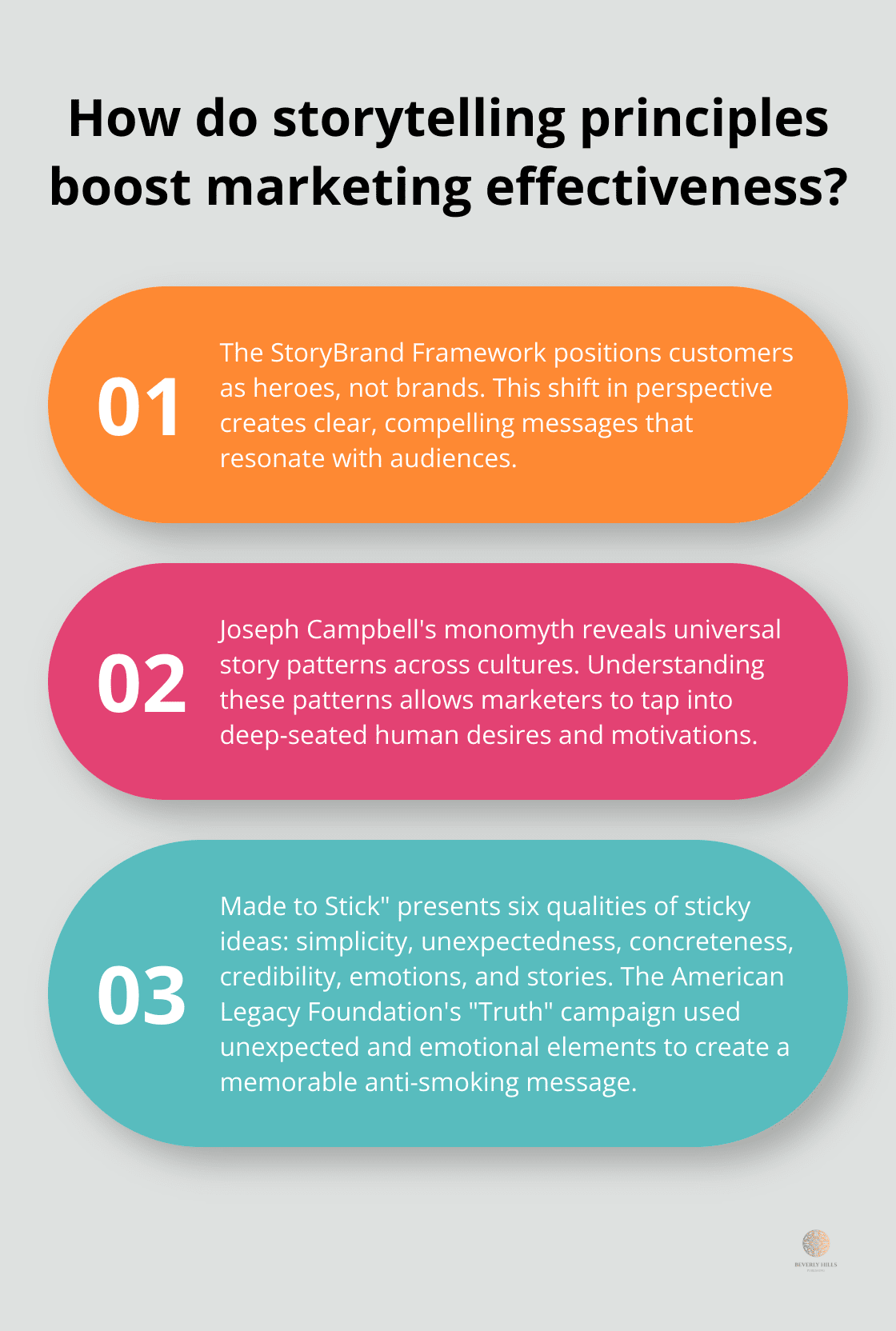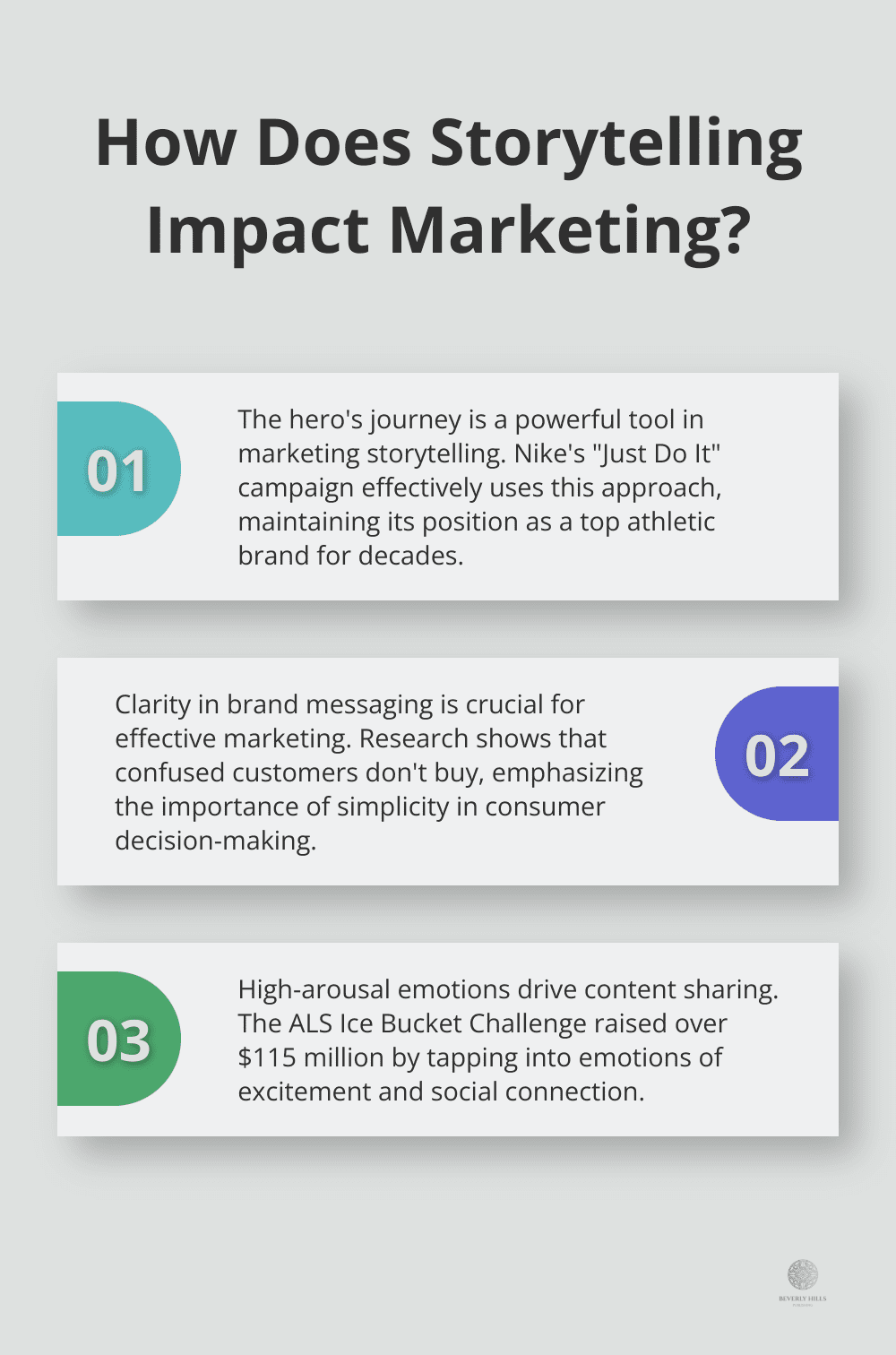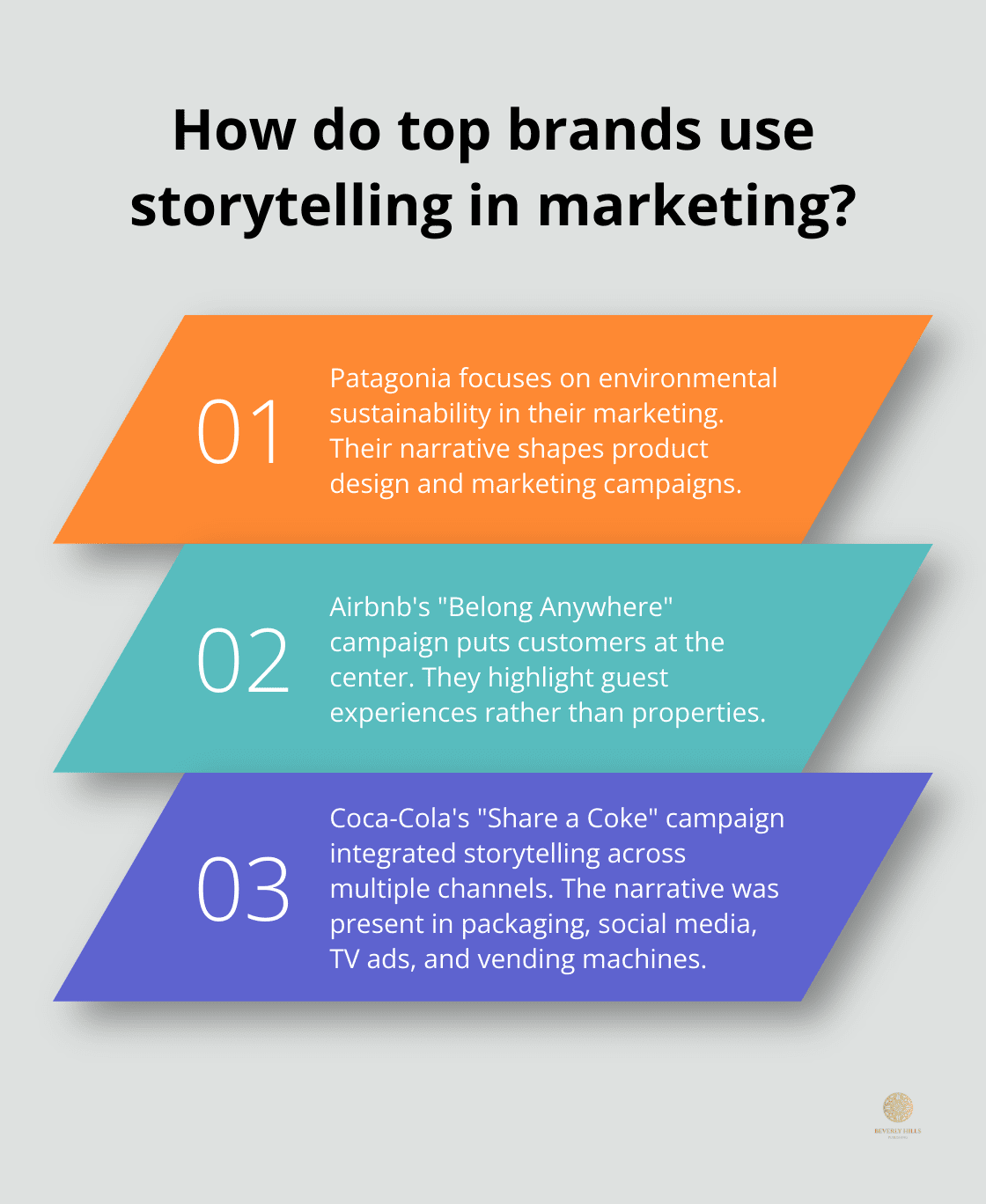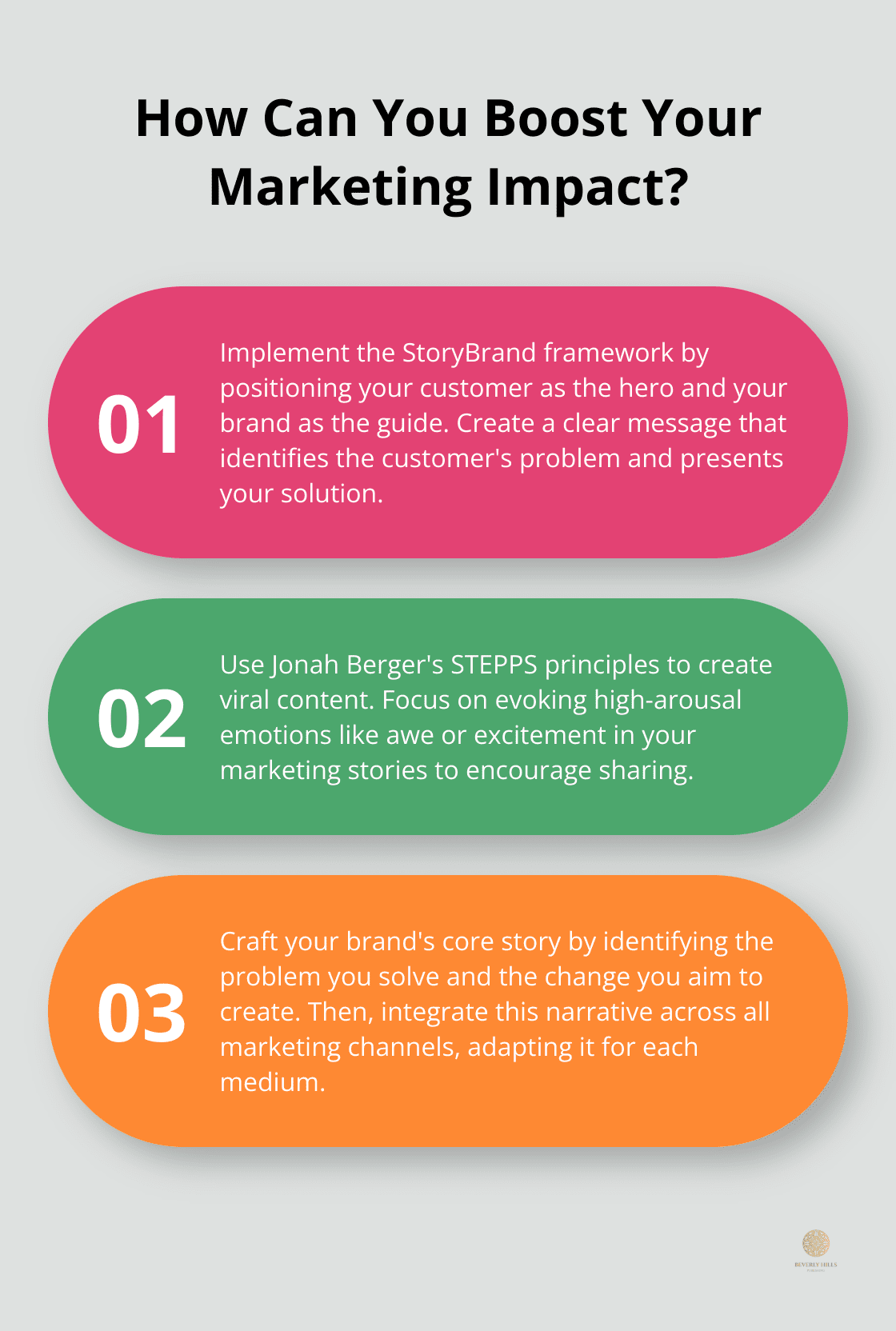Storytelling marketing has become a powerful tool in the modern business landscape. At Beverly Hills Publishing, we’ve seen firsthand how compelling narratives can transform brands and captivate audiences.
This blog post will guide you through essential storytelling marketing books that can elevate your marketing strategies. We’ll explore key takeaways from these reads and provide practical tips for applying storytelling techniques in your campaigns.
Essential Reads for Storytelling Marketing
The StoryBrand Framework
Donald Miller’s “Building a StoryBrand” revolutionizes brand messaging. Miller’s framework positions your customer as the hero, not your brand. This shift in perspective helps create clear, compelling messages that resonate with your audience. The seven-part framework includes elements like identifying the customer’s problem and presenting your brand as the guide to solve it. Many businesses have seen significant improvements in marketing clarity and effectiveness after implementing this framework.
Universal Story Patterns
Joseph Campbell’s “The Hero with a Thousand Faces” might seem an unusual choice for marketers. However, this seminal work on mythology provides invaluable insights into storytelling structures that resonate across cultures. Campbell’s monomyth refers to the “one story” whose pattern has dominated myths from all times and cultures. Understanding these universal story patterns allows you to craft campaigns that tap into deep-seated human desires and motivations.
Creating Sticky Ideas
In “Made to Stick,” Chip and Dan Heath explore why some ideas thrive while others die. They present six key qualities of “sticky” ideas: simplicity, unexpectedness, concreteness, credibility, emotions, and stories. The book brims with case studies and practical examples of how these principles apply in marketing. For instance, the authors discuss how the American Legacy Foundation’s “Truth” campaign used unexpected and emotional elements to create a memorable anti-smoking message.
The Science of Viral Content
Jonah Berger’s “Contagious: Why Things Catch On” offers a data-driven approach to creating shareable content. Berger identifies six key STEPPS that make content viral: Social Currency, Triggers, Emotion, Public, Practical Value, and Stories. Each principle comes with research and real-world examples. For instance, Berger explains how Blendtec’s “Will It Blend?” videos leveraged both practical value and unexpectedness to go viral, increasing sales by 700%.
Applying Storytelling Principles
These books provide a solid foundation for anyone who wants to enhance their storytelling marketing skills. The principles from these works equip you to create narratives that captivate your audience and drive brand engagement. As you read through these essential works, you’ll discover how to weave compelling stories into your marketing strategies (a skill that can set you apart in today’s competitive landscape).

The next chapter will explore key takeaways from storytelling marketing literature, providing you with actionable insights to implement in your campaigns.
Storytelling Essentials for Marketers
The Hero’s Journey in Marketing
The hero’s journey, a concept popularized by Joseph Campbell, serves as a powerful tool in marketing storytelling. This narrative archetype typically follows the steps of a hero who goes on an adventure, learns a lesson, and returns transformed. In marketing, this structure positions your customer as the hero facing a challenge, with your brand as the guide helping them overcome it. Nike’s “Just Do It” campaign effectively casts the consumer as the hero, with Nike products as the tools to help them achieve their goals. This approach has helped Nike maintain its position as a top athletic brand for decades.
Clarity: The Key to Effective Messaging
Donald Miller’s StoryBrand framework emphasizes the importance of clarity in brand messaging. Many marketers fall into the trap of prioritizing cleverness over clarity. However, research shows that confused customers don’t buy. Marketers who focus on simplifying consumers’ decision making will rise above the din, and their customers will stick by them as a result. When you craft your brand story, focus on simplicity and clarity to ensure your message resonates with your audience.
Emotional Connections That Drive Action
Jonah Berger’s research in “Contagious” highlights the critical role of emotions in making content shareable. High-arousal emotions (like awe, anger, or anxiety) are more likely to drive sharing behavior. The ALS Ice Bucket Challenge went viral in 2014, raising over $115 million for ALS research by tapping into emotions of excitement and social connection. When you develop your marketing stories, consider how you can evoke strong emotions that align with your brand values and encourage sharing.
Creating Memorable Content
The Heath brothers’ “Made to Stick” principles offer a practical framework for creating memorable content. One key takeaway is the power of concrete imagery. Abstract concepts are hard to remember, while specific, vivid details stick in our minds. Airbnb’s “Belong Anywhere” campaign uses specific, relatable stories of hosts and guests to bring their abstract concept to life. This approach has helped Airbnb build a strong brand identity in a crowded market.
Authenticity in Storytelling
Effective storytelling in marketing doesn’t manipulate your audience. It creates authentic connections and provides real value. As you apply these principles, always keep your audience’s needs and desires at the forefront of your storytelling efforts. This approach will help you build trust and credibility with your target market.

The next chapter will explore practical ways to apply these storytelling techniques in your marketing campaigns, helping you create compelling narratives that resonate with your audience and drive results.
Crafting Your Brand’s Narrative
Find Your Core Story
Your brand’s core story forms the foundation of your marketing efforts. It’s not just about what you do, but why you do it. Patagonia, for example, doesn’t just sell outdoor gear; their marketing strategy is focused on environmental sustainability and creating radical change. This narrative shapes everything from their product design to their marketing campaigns. To uncover your core story, ask yourself: What problem do you solve? Why does your brand exist? What change do you aim to create in the world?
Put Your Customer at the Center
After you identify your core story, shift the focus to your customer. They should become the hero of your narrative, not your brand. Airbnb excels at this with their “Belong Anywhere” campaign. Instead of focusing on their properties, they highlight the experiences of their guests. When you craft your narrative, consider: What journey does your customer take? What challenges do they face? How does your product or service help them overcome these challenges?
Integrate Across Channels
Your story shouldn’t exist in isolation. You need to weave it throughout all your marketing channels. Coca-Cola’s “Share a Coke” campaign exemplifies this approach. The story of personal connection integrated across packaging, social media, TV ads, and even vending machines. When you plan your campaign, think about how you can tell your story through different mediums. How can you adapt your narrative for social media? For email marketing? For your website?
Measure Your Story’s Impact
While storytelling’s impact can challenge measurement, it’s not impossible. Look at metrics like brand recall, customer loyalty, and emotional engagement. Nike’s “Dream Crazy” campaign featuring Colin Kaepernick provides an excellent example. Track metrics before and after you implement your storytelling strategy. Has your customer retention improved? Has your social media engagement increased? These indicators can signal your story’s resonance.
Refine and Adapt
Effective storytelling in marketing requires constant refinement based on audience feedback and performance metrics. You should regularly review and adjust your narrative to ensure it continues to resonate with your audience. This might involve tweaking your message, exploring new channels, or even reimagining your core story as your brand evolves. The most successful brands consistently refine their storytelling to stay relevant and impactful.

Final Thoughts
Storytelling marketing books provide invaluable insights for crafting compelling narratives that resonate with audiences. These resources offer practical frameworks and strategies proven effective in real-world marketing scenarios. You can transform your marketing approach and forge deeper connections with your audience through understanding the hero’s journey, creating sticky ideas, and leveraging emotional connections.

The power of storytelling in marketing extends beyond selling products or services. It creates meaningful experiences that customers want to join, turning brands into movements and customers into advocates. Effective storytelling requires continuous learning, experimentation, and refinement based on audience feedback and results.
At Beverly Hills Publishing, we combine innovative publishing strategies with strategic branding to help authors craft compelling narratives. We encourage you to explore new ideas, stay curious about your audience, and refine your narrative (this practice will help you harness storytelling’s power to create marketing that inspires and engages). Your dedication to storytelling can elevate your marketing efforts and transform your brand’s impact.















































































































































































































































